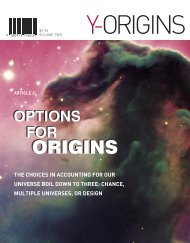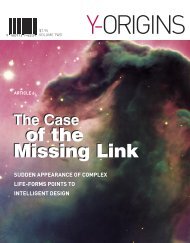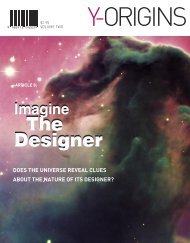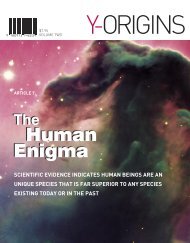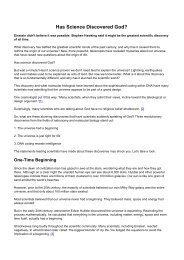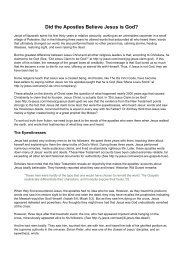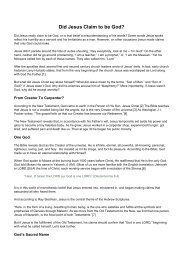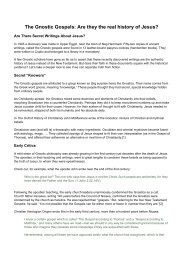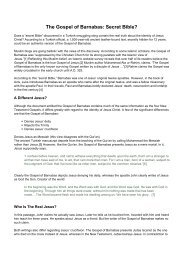Odds2
Create successful ePaper yourself
Turn your PDF publications into a flip-book with our unique Google optimized e-Paper software.
$7.95<br />
VOLUME TWO<br />
Y-ORIGINS<br />
ARTICLE 2:<br />
What<br />
Are<br />
the ODDS?<br />
IT’S BECOMING CLEAR THAT THE EARTH<br />
IS JUST RIGHT FOR LIFE TO EXIST–AND<br />
EVERYWHERE ELSE IS ALL WRONG
INSTRUCTIONS<br />
To view the layout and graphics, click on the Facing icon on the<br />
right side of your bottom tool bar in your Acrobat Reader © file. Try viewing at 75%.<br />
To read the article, click on the Single Page icon on the bottom right of your<br />
Acrobat Reader © file.<br />
To enlarge the print for easier viewing, click on the “+” by the<br />
magnifcation percentage in the middle of the tool bar at the top of the page.<br />
To move from one page to another, use your side scroll bar or click on the<br />
left or right arrow in the bottom tool bar.<br />
CLICK HERE to see other articles from Y-Jesus Magazine at www.y-zine.com<br />
Chief Editor: Larry Chapman<br />
Project Coordinator: Helmut Teichert<br />
Editorial Director: Rick James<br />
Design: Hydragraphik ® Studio ( www.hydragraphik.com )<br />
Sun Mountain Productions<br />
Article Editors: Rick James, Eric Stanford<br />
Copy Editor: Eric Stanford<br />
Writers: Larry Chapman, Rick James, Eric Stanford<br />
Y-ZINE<br />
PO Box 6017<br />
Great Falls, MT 59405<br />
Copyright 2006 by Bright Media Foundation and B & L Publications. All rights reserved.<br />
ISBN 0-9717422-3-5<br />
2 • Y-ORIGINS
What Are the Odds?<br />
Click on the e-article title for contents<br />
IT’S BECOMING CLEAR THAT THE EARTH IS JUST RIGHT<br />
FOR LIFE TO EXIST — AND EVERYWHERE ELSE IS<br />
ALL WRONG Page 6<br />
THEY DON’T CALL THESE NUMBERS<br />
ASTRONOMICAL FOR NOTHING Page 6<br />
A FINELY TUNED UNIVERSE Page 7<br />
A FINELY TUNED GALAXY Page 8<br />
A FINELY TUNED SOLAR SYSTEM Page 8<br />
A FINELY TUNED PLANET Page 8<br />
ONE BLOOMING ROCK Page 9<br />
THE MATH MIRACLE Page 9<br />
ENDNOTES Page 10<br />
WATER WORLD Page 12<br />
ACKNOWLEDGMENTS<br />
I am indebted to Dr. Bill Bright, who passed away before this project was finished. Dr. Bright enthusiastically endorsed and<br />
contributed to the development of the material presented in this endeavor.<br />
Special thanks are also due to Rick James and Eric Stanford, who have both spent countless hours clarifying some of the concepts<br />
presented.<br />
Several others have contributed greatly to the writing of these articles, including Dr. Henry Brandt, Dave Chapman, Dr. Bert<br />
Harned, and New Testament scholar, Dr. Ron Heine. The valuable input from Brian Ricci, ‘Jamin Latvala, and the Campus Crusade<br />
staff at the University of Washington were especially helpful and constructive. Special thanks also are due Helmut Teichert of<br />
Bright Media, who has been the overall director of the project. Finally I would like to thank my wife, Marianne, for inspiring me to<br />
undertake this effort.<br />
Larry Chapman<br />
TABLE OF CONTENTS • 3
4• WHAT ARE THE ODDS • ARTICLE 2
WHAT ARE<br />
THE ODDS?<br />
life in our universe is so<br />
improbable that it defies a natural<br />
explanation.<br />
WHAT ARE THE ODDS • ARTICLE 2 • 5
In his movie Signs, M. Night Shyamalan presents us with a priest (played<br />
by Mel Gibson) who has lost his faith. Through the death of his wife, the<br />
priest has come to the conclusion that life is random. He has decided<br />
that he will no longer pretend to see God in the picture.<br />
As Shyamalan zooms in his lens, he shows<br />
us that life is without focus: there is no recognizable<br />
pattern. But typical of Shyamalan,<br />
he turns the lens one more screw to the<br />
right, and at this magnification a pattern<br />
emerges. Gibson’s character is able to see<br />
the hand of a great designer lurking behind<br />
all that had seemed random. His wife’s<br />
dying words, his daughter’s obsession with<br />
water, his son’s asthma—everything served<br />
a larger purpose.<br />
At the end Mel Gibson returns to the priesthood<br />
and makes a blockbuster called The<br />
Passion of the Christ. Well, not exactly, but<br />
his character comes full circle—from faith<br />
to skepticism and back to faith. Meanwhile,<br />
Shyamalan takes his audience on the same<br />
circuitous journey, exploring issues of design<br />
and higher purpose in the world.<br />
In many ways the evidence for intelligent<br />
design of the universe has come full circle.<br />
When early humans looked at the heavens,<br />
they could not escape the concept<br />
of a creator. In fact, until the 1500s, most<br />
people believed in the ancient astronomer<br />
Ptolemy’s teaching, that Earth was the<br />
center of the universe.<br />
But, in the 16 th century, Copernicus showed<br />
that Earth revolved around the Sun. Suddenly<br />
our planet seemed less special. Some<br />
astronomers looked out at the universe<br />
through telescopes and deduced a creator<br />
was unnecessary. Their argument for a<br />
materialist worldview was energized by the<br />
belief in an ordinary Earth.<br />
Although the founders of modern astronomy<br />
strongly believed that the universe was the<br />
work of a cosmic genius, these later followers<br />
saw the cosmos as totally autonomous<br />
and independent of a designer. Copernicus,<br />
a strong believer in God, couldn’t have disagreed<br />
more with such an assumption, and<br />
would have taken exception to it.<br />
In the 19 th century, this belief in an ordinary<br />
Earth became popularized as the “Copernican<br />
Principle.” This principle has become<br />
the bedrock for a materialistic view of the<br />
world. However,in the latter part of the 20 th<br />
century evidence began pouring in about<br />
the remarkable fitness of Earth for life.<br />
Scientists have learned that only an exceptionally<br />
fine-tuned planet like Earth has the<br />
necessary ingredients to harbor life. Additionally,<br />
our solar system and galaxy, as well<br />
as our entire universe, appear designed to<br />
support intelligent life.<br />
The odds that such fine-tuning could have<br />
occurred by chance is not just unlikely–scientists<br />
say it is virtually impossible.<br />
THEY DON’T<br />
CALL THESE<br />
NUMBERS<br />
ASTRONOMICAL<br />
FOR NOTHING<br />
An article in U.S. News & World Report<br />
remarks, “So far no theory is even close<br />
to explaining why physical laws exist,<br />
much less why they take the form they do.<br />
Standard big bang theory, for example, essentially<br />
explains the propitious universe in<br />
this way: ‘Well, we got lucky.’ ” 1<br />
On Christmas Day in 2002, Jack Whitaker,<br />
of Scott Depot, West Virginia, got lucky,<br />
becoming the largest single-ticket lottery<br />
jackpot winner until that time in North<br />
America. His prize? A Powerball jackpot<br />
of $314.9 million. Over a hundred million<br />
other tickets didn’t match. What are the<br />
odds of that? (And what are the odds that<br />
within two years he would be robbed twice,<br />
face charges for attacking a bar manager,<br />
6• WHAT ARE THE ODDS • ARTICLE 2
e sued for making trouble at a nightclub<br />
and a racetrack, and be arrested twice for<br />
drunk driving? Not nearly as unlikely as his<br />
Powerball winning ticket, but still true.)<br />
If someone won even two such lotteries<br />
consecutively, we would all assume the<br />
results were rigged. And yet, when it comes<br />
to life existing in our universe, the odds are<br />
far more remote than winning a hundred<br />
Powerball lotteries consecutively.<br />
Physicist Paul Davies comments, “The<br />
conclusion must be that we live in a world<br />
of astronomical unlikelihood.” 2<br />
Donald Page of Princeton’s Institute for<br />
Advanced Study has calculated that the<br />
odds against our universe randomly taking<br />
a form suitable for life is one out of 10 124 , a<br />
number beyond imagination. 3<br />
To try and visualize the difficulty, imagine<br />
all the grains of sand on all the beaches on<br />
Earth. Then encrypt one grain with a special<br />
code known only to you, and randomly<br />
bury that grain on a beach somewhere on<br />
Earth. (Maybe enjoy a vacation in Maui<br />
while you’re at it).<br />
The chance a blindfolded person would<br />
ever discover that one grain of sand on their<br />
first pick is one out of 10 20 (one chance in<br />
100 billion billion.)<br />
Now offer a reward to anyone who can find<br />
it on one pick, even though they don’t know<br />
which beach to scour, or how deep it is<br />
buried. But what if they did? Would anyone<br />
believe they discovered it by accident? Yet,<br />
scientists tell us that the likelihood of a big<br />
bang explosion resulting in a universe able<br />
to support life like ours is many times more<br />
improbable.<br />
As we consider the odds for the fine-tuning<br />
of our universe, galaxy, solar system,<br />
and planet, let’s keep in mind just how<br />
extreme these odds really are. Not just one,<br />
but all of them require unbelievably precise<br />
fine-tuning. Can such precision be a result<br />
of anything other than design? Let’s take a<br />
look at why many scientists are asking this<br />
question.<br />
A FINELY<br />
TUNED UNIVERSE<br />
Dr. Robin Collins states in The Case for a<br />
Creator, “Over the past thirty years or so,<br />
scientists have discovered that just about<br />
everything about the basic structure of the<br />
universe is balanced on a razor’s edge.” 4<br />
Over 35 different characteristics of the<br />
universe and its physical laws must be<br />
precisely fine-tuned for physical life to be<br />
possible. 5 Following are six of those characteristics:<br />
1. A large enough expansion rate. The<br />
birth of the universe had to begin with<br />
enough force, or life couldn’t exist.<br />
Stephen Hawking states, “If the rate of<br />
expansion one second after the big bang<br />
had been smaller by even one part in a<br />
hundred thousand million million, the<br />
universe would have recollapsed before<br />
it ever reached its present size.” 6<br />
2. A controlled expansion rate. Although<br />
the expansion rate had to be great<br />
enough for the universe to avoid a big<br />
crunch, if its outward force had been<br />
even a fraction greater, that would have<br />
been too much for gravity to form stars<br />
and planets. Life could never have been<br />
possible. 7<br />
3. Force of gravity. If the gravitational<br />
force were altered by 0.000000000000000<br />
00000000000000000000001 percent, neither<br />
Earth nor our Sun would exist—and<br />
you would not be here reading this. 8<br />
4. The balance of matter and antimatter.<br />
In the formation of the universe, the balance<br />
between matter and antimatter,<br />
and the excess of matter over antimatter,<br />
needed to be accurate to one part in<br />
ten billion for the universe to arise.<br />
5. The mass density of the universe. For<br />
physical life to exist, the mass density<br />
of the universe must be fine-tuned to<br />
better than one part in a trillion trillion<br />
trillion trillion trillion (10 60 ). 9 Thus, the<br />
mass contained in all dark and visible<br />
matter, including stars, is essential for<br />
the existence of our universe.<br />
“SO FAR NO THEORY IS EVEN CLOSE TO EXPLAINING WHY PHYSICAL LAWS EXIST,<br />
MUCH LESS WHY THEY TAKE THE FORM THEY DO. STANDARD BIG BANG THEORY,<br />
FOR EXAMPLE, ESSENTIALLY EXPLAINS THE PROPITIOUS UNIVERSE IN THIS WAY:<br />
‘WELL, WE GOT LUCKY.’”<br />
—U.S. NEWS & WORLD REPORT<br />
WHAT ARE THE ODDS • ARTICLE 2 • 7
6. Space-energy density. The spaceenergy<br />
density of the universe requires<br />
much greater precision than the mass<br />
density. For physical life to be possible,<br />
it must be fine-tuned to one part in<br />
10 120 . 10<br />
According to the big bang theory, all of this<br />
minute fine-tuning was programmed into<br />
the initial conditions of the first microsecond<br />
of the explosion that began our<br />
universe. At that instant the rate and ratios<br />
of expansion, mass, density, antimatter,<br />
matter, etc., were set in place, eventually<br />
leading to a habitable planet called Earth.<br />
In addition to the 35 different characteristics<br />
of our universe that must be just right<br />
for life to exist, our galaxy, solar system,<br />
and planet also needed to be exceptionally<br />
fine-tuned or we would not be here. 11<br />
A FINELY TUNED GALAXY<br />
Galaxies are formations of from millions to<br />
perhaps a trillion stars. Our own galaxy is<br />
called the Milky Way. It’s unknown how<br />
many galaxies the universe contains, but it<br />
may be around a trillion. Surprisingly, given<br />
the great number of these star groups, most<br />
galaxies are incompatible with life.<br />
In order for life to exist in a galaxy, it needs<br />
to meet several criteria. 12 The following are<br />
just three of the fine-tuned characteristics a<br />
galaxy needs to support life:<br />
Shape of the galaxy. The Milky Way is spiralshaped.<br />
Of the three types of galaxies—elliptical,<br />
irregular, and spiral— the spiral type is<br />
most capable of hosting human life.<br />
Not too large a galaxy. Our Milky Way<br />
is enormous, measuring 100,000 lightyears<br />
from end to end. However, if it<br />
were just a bit larger, too much radiation<br />
and too many gravitational disturbances<br />
would prohibit life like ours.<br />
Not too small a galaxy. On the other<br />
hand, a stable Earth orbit that is necessary<br />
for life could not exist if our galaxy<br />
were slightly smaller. And a smaller galaxy<br />
would result in inadequate heavy<br />
elements, such as iron and carbon,<br />
essential to life.<br />
Our Milky Way galaxy meets these and many<br />
other conditions essential for life. Most of the<br />
others do not.<br />
When we focus in even closer, on our own<br />
star and its planets, the odds for life being<br />
possible become even more extreme.<br />
A FINELY TUNED<br />
SOLAR SYSTEM<br />
Copernicus’s theory that Earth revolved<br />
around the Sun, seemed to relegate our<br />
planet to an ordinary status in the universe.<br />
However, if Earth was the center<br />
of our solar system, as Ptolemy and 16th<br />
century Catholic Church leaders had<br />
taught, we wouldn’t be here. None of<br />
them, including Copernicus, knew that in<br />
order for human life to be possible, Earth<br />
needs to revolve around a Sun that has<br />
just the right size, location, and conditions<br />
as ours does.<br />
But that is not all. We need other planets<br />
such as Jupiter and Mars to act as defense<br />
shields, protecting us from a potential<br />
catastrophic bombardment of comets and<br />
meteors. We also need a moon of just the<br />
right size and position to impact our tides<br />
and seasons. Let’s take a look at just a few<br />
of the many conditions in our solar system<br />
that are just right for life.<br />
The Sun’s distance from the center<br />
of the galaxy. Our Sun is positioned<br />
thousands of light-years from the center<br />
of the Milky Way, near one of its spiral<br />
arms. 13 This is the safest part of the<br />
galaxy, away from its highly radioactive<br />
center.<br />
The Sun’s mass not too large. If the<br />
mass of the Sun were a small percentage<br />
greater, it would burn too quickly<br />
and erratically to support life.<br />
The Sun’s mass not too small. On the<br />
other hand, if it were smaller, its greater<br />
flaring would disrupt Earth’s rotation<br />
rate.<br />
The Sun’s metal content. Only two percent<br />
of all stars have enough metal content<br />
to form planets. Too much metal<br />
in a star will allow too many planets to<br />
form, creating chaos. Our Sun has just<br />
the right amount of metal for planets to<br />
form safely.<br />
Effect of the Moon. The Moon stabilizes<br />
the Earth’s tilt and is responsible for<br />
our seasons. If it weren’t there, our tilt<br />
could swing widely over a large range,<br />
making our winters a hundred degrees<br />
colder and our summers a hundred<br />
degrees warmer.<br />
When astronomers consider our remarkable<br />
solar system, they acknowledge that if it<br />
was slightly different, advanced biologi-<br />
8• WHAT ARE THE ODDS • ARTICLE 2
cal life would be impossible. But it is not<br />
enough to have the right universe, galaxy,<br />
and solar system for human life to be possible.<br />
The conditions of our home planet<br />
must also be fine-tuned to a razor’s edge.<br />
A FINELY TUNED PLANET<br />
You may believe that aliens have sent life to<br />
Earth from a far distant galaxy (the premise<br />
of that memorable drama from 2004, AVP:<br />
Alien vs. Predator). You may believe that the<br />
government is hiding something outer spatial<br />
in Nevada’s mysterious Area 51. Or you<br />
may simply believe that there is undoubtedly<br />
intelligent life on other planets. In any case,<br />
we have all been raised on the assumption<br />
that, given enough time, intelligent life will<br />
spring up anywhere in the cosmos (with<br />
perhaps a few more eyeballs or reptilian<br />
features). Yet new evidence from cosmology<br />
is really saying the opposite.<br />
The reality is that we live on an extremely<br />
rare planet perfectly positioned in an extremely<br />
rare solar system, ideally located in<br />
an extremely rare galaxy, within a highly<br />
improbable universe. Let’s look at our rare<br />
Earth.<br />
Water. Earth has an abundance of<br />
water, which is essential for life. Mars<br />
once had water and therefore might<br />
have harbored life. But water is only one<br />
of many requirements for life.<br />
Oxygen. Earth is the only planet in our<br />
solar system in which we can breathe.<br />
Attempting to breathe on other planets,<br />
such as Mars or Venus, would be<br />
instantly fatal, Mars having virtually no<br />
atmosphere and Venus having mostly<br />
carbon dioxide and almost no oxygen.<br />
Earth’s distance from the Sun. If the<br />
Earth were merely one percent closer<br />
to the Sun, the oceans would vaporize,<br />
preventing the existence of life. On the<br />
other hand, if our planet were just two<br />
percent farther from the Sun, the oceans<br />
would freeze and the rain that enables<br />
life would be nonexistent.<br />
Plate tectonic activity on Earth. Scientists<br />
have determined that if the plate<br />
tectonic activity were greater, human<br />
life could not be sustained and greenhouse-gas<br />
reduction would overcompensate<br />
for increasing solar luminosity.<br />
Yet, if the activity was smaller, life-essential<br />
nutrients would not be recycled<br />
adequately and greenhouse-gas reduc<br />
THE<br />
MATH<br />
MIRACLE<br />
Implicit in all of the scientific discoveries of<br />
fine-tuning in the universe is the foundational<br />
importance of mathematics to exploring<br />
the nature of the universe. Because mathematics<br />
is the lens by which we study the<br />
universe, we can miss the genius behind the<br />
lens itself.<br />
Physicist Eugene Wigner, in a widely quoted<br />
paper entitled “The Unreasonable Effectiveness<br />
of Mathematics in the Physical<br />
Sciences,” notes that scientists often take for<br />
granted that the math they use to study and<br />
quantify the miracles of the universe is miraculous<br />
itself. Wigner states, “The enormous<br />
usefulness of mathematics is something<br />
bordering on the mysterious. … There is no<br />
rational explanation for it. … The miracle of<br />
the appropriateness of the language of mathematics<br />
for the formulation of the laws of<br />
physics is a wonderful gift which we neither<br />
understand nor deserve.” 14<br />
Such is the nature of mathematics that no<br />
one would claim to have invented an equation<br />
but only to have discovered or uncovered<br />
something that was always true. As the<br />
great scientist Johannes Kepler stated, “The<br />
chief aim of all investigations of the external<br />
world should be to discover the rational order<br />
and harmony which has been imposed on it<br />
by God and which He revealed to us in the<br />
language of mathematics.”<br />
Even as we calculate the extreme precision<br />
by which the universe was designed, we<br />
are alerted to yet another contour of design<br />
in the universe: the mathematical laws of<br />
physics.<br />
WHAT ARE THE ODDS • ARTICLE 2 • 9
tion would not compensate for increasing<br />
solar luminosity.<br />
Ozone level in the atmosphere. Life on<br />
Earth survives because the ozone level<br />
is within the safe range for habitation.<br />
However, if the ozone level were<br />
either much less or much greater, plant<br />
growth would be inadequate for human<br />
life to exist.<br />
For life to exist, these, as well as many other<br />
conditions needs to be just right. 15<br />
ONE BLOOMING<br />
ROCK<br />
University of Washington professors Peter<br />
Ward and Donald Brownlee conclude in their<br />
book, Rare Earth, that the conditions favorable<br />
for life must be so rare in the universe<br />
that “not only intelligent life, but even the<br />
simplest of animal life is exceedingly rare in<br />
our galaxy and in the universe.” 16 This has<br />
led their readers to the conclusion expressed<br />
by the reviewer from the New York Times:<br />
“Maybe we are alone in the universe, after<br />
all.” 17<br />
If Ward and Brownlee are right, what does<br />
that mean to us?<br />
Michael Denton, senior research fellow in<br />
human molecular genetics at the University<br />
of Otago in New Zealand, tells us why this<br />
remarkable fine-tuning has reopened the<br />
discussion on the importance of man in our<br />
lonely universe. 18<br />
No other theory or concept imagined by<br />
man can equal in boldness and audacity<br />
this great claim … that all the starry<br />
heavens, and every species of life, that<br />
every characteristic of reality exists for<br />
mankind. … And today, four centuries<br />
after the scientific revolution, the doctrine<br />
is again reemerging. In the last decades<br />
of the twentieth century, its credibility is<br />
being enhanced by discoveries in several<br />
branches of fundamental science.<br />
It seems ludicrous to claim that life exists<br />
on only one tiny speck in a universe of ten<br />
billion trillion stars. Yet, incredibly, Earth<br />
appears to sit alone in a hostile universe<br />
devoid of life, a reality portrayed recently in<br />
National Geographic:<br />
If life sprang up through natural<br />
processes on the Earth, then the same<br />
thing could presumably happen on<br />
other worlds. And yet when we look at<br />
outer space, we do not see an environment<br />
teeming with life.<br />
We see planets and moons where no life<br />
as we know it could possibly survive. In<br />
fact we see all sorts of wildly different<br />
planets and moons—hot places, murky<br />
places, ice worlds, gas worlds—and it<br />
seems that there are far more ways to<br />
be a dead world than a live one. 18<br />
The incredibly precise numerical values<br />
required for life confront scientists with<br />
obvious implications. Stephen Hawking<br />
observes, “The remarkable fact is that the<br />
values of these numbers seem to have been<br />
very finely adjusted to make possible the<br />
development of life.” 19<br />
ENDNOTES<br />
1. Gregg Easterbrook, “Before the Big<br />
Bang,” U.S. News & World Report, special<br />
edition, 2003, 16.<br />
2. Paul Davies, Other Worlds (London: Penguin,<br />
1990), 169.<br />
3. Dietrick E. Thompsen, “The Quantum<br />
Universe: A Zero-Point Fluctuation?” Science<br />
News, August 3, 1985, 73.<br />
4. Quoted in Lee Strobel, The Case for a<br />
Creator (Grand Rapids, MI: Zondervan,<br />
2004), 131.<br />
5. Hugh Ross, The Creator and the Cosmos,<br />
3rd ed. (Colorado Springs, CO: NavPress,<br />
2001), 224.<br />
6. Stephen Hawking, A Brief History of<br />
Time (New York: Bantam, 1990), 121–122.<br />
7. John D. Barrow and George Silk, The Left<br />
Hand of Creation: The Origin and Evolution<br />
of the Expanding Universe (New York:<br />
Basic, 1983), 206.<br />
8. Lawrence M. Krauss, “The End of the<br />
Age Problem and the Case for a Cosmological<br />
Constant Revisited,” Astrophysical<br />
Journal 501 (1998): 461–466.<br />
9. Ross, 53.<br />
10. Ibid., 187.<br />
11. Ibid., 187–193.<br />
12. Guillermo Gonzalez and Jay W. Richards,<br />
The Privileged Planet (Washington,<br />
DC: Regnery, 2004), 132–138.<br />
13. Ibid., 132–138.<br />
14. Eugene Wigner, “The Unreasonable Effectiveness<br />
of Mathematics in the Physical<br />
Sciences,” Communications on Pure and<br />
Applied Mathematics 13 (1960), 1-14.<br />
15. Ross. 175-199.<br />
16. Peter D. Ward and Donald Brownlee,<br />
Rare Earth (New York: Copernicus, 2000).<br />
17. William J. Broad, “Maybe We Are Alone<br />
in the Universe After All,”New York Times,<br />
(February 8, 2000), 1-4.<br />
18. Michael J. Denton, Nature’s Destiny:<br />
How the Laws of Biology Reveal Purpose<br />
in the Universe (New York: The Free Press,<br />
1998), 3-4.<br />
19. Joel Achenbach, “Life Beyond Earth,”<br />
National Geographic (January, 2000, Special<br />
Millennium Issue), 45.<br />
20. Hawking, 124.<br />
21.Quoted in Strobel, 165.<br />
22. Ibid.<br />
10• WHAT ARE THE ODDS • ARTICLE 2
WHAT ARE THE ODDS • ARTICLE 2 • 11
WATER<br />
WORLD<br />
It seems like every other day you see reports in the<br />
paper about scientists getting excited that water<br />
has been discovered on our Moon. Or on a planet in<br />
our solar system. Or on some other celestial body.<br />
From the news stories, you might almost think that<br />
all it takes is a little water for life to exist somewhere.<br />
Is that true?<br />
In his book The Case for a Creator, author Lee<br />
Strobel asks Dr. Guillermo Gonzalez, an astrobiologist<br />
at Iowa State University, can’t one simply find<br />
a place in the universe where water stays liquid<br />
for a long enough period of time and eventually life<br />
may develop?<br />
Gonzalez responds: “It’s true that in order to<br />
have life you need water—which is the universal<br />
solvent—for reactions to take place, as well as<br />
carbon, which serves as the core atoms of information<br />
carrying structural molecules of life. But you<br />
also need a lot more. Humans require twenty-six<br />
essential elements; a bacterium about sixteen. The<br />
problem is that not just any planetary body will be<br />
the source of all those chemical ingredients in the<br />
necessary forms and amounts.” 21<br />
Now here is the interesting follow-up question.<br />
Strobel asks whether, as science fiction writers<br />
have suggested, life couldn’t develop in a “radically<br />
different form—for instance, creatures based<br />
on silicon instead of carbon.” In other words, what<br />
about all those strange creatures we’ve seen on<br />
Star Trek?<br />
Here is Gonzalez’s response: “Chemistry is one<br />
of the better understood areas of science. We<br />
know that you just can’t get certain atoms to stick<br />
together in sufficient numbers and complexity to<br />
give you large molecules like carbon can. You can’t<br />
get around it. And you just can’t get other types<br />
of liquids to dissolve as many different kinds of<br />
chemicals as you can with water.” 22<br />
The point? Next time you hear about some ice<br />
on an asteroid, don’t go looking for your distant<br />
cousins.<br />
12• WHAT ARE THE ODDS • ARTICLE 2
WHAT ARE THE ODDS • ARTICLE 2 • 13
“WHAT ARE THE ODDS?” IS ONE OF EIGHT ARTICLES FROM<br />
Y-ORIGINS MAGAZINE<br />
Back to the Beginning<br />
Scientific discoveries revive the ancient belief in a beginning to the universe.<br />
What are the Odds?<br />
It’s becoming clear that life on earth is unique and the odds against it existing elsewhere are<br />
astronomical.<br />
Options for Origins<br />
The choices in accounting for out universe boil down to three -—chance, multiple universes, or design.<br />
The Problem with Half an Eye<br />
Can intricately complex organs like the eye be the result of time plus chance?<br />
The Language of Our Cells<br />
Does the intelligence of DNA point to a Designer?<br />
The Case of the Missing Links<br />
Where are Darwin’s predicted fossils?<br />
DISCOVER IN Y-ORIGINS:<br />
Leading scientists like Einstein admit to a “superintelligence.”<br />
DNA causes leading atheist to renounce 50 years of unbelief<br />
DNA stuns evolutionists by tracing all humans to a single parent<br />
The Human Enigma<br />
Evolutionists are unable to explain the origin of human intelligence and consciousness.<br />
Imagine the Designer<br />
Does the universe reveal clues about the nature of its designer?<br />
New theories predict other dimensions that make “miracles” possible<br />
The Creator has left clues in the cosmos that tell us what He is like.<br />
This colorful, easy-to-read magazine provides startling insights about our<br />
origins from such leading scientists as Stephen Hawking, Stephen Jay Gould,<br />
Roger Penrose, and Paul Davies.In his review of Y-Origins Jon Greene writes,<br />
“Y-Origins is a wonderful work on intelligent design, designed to appeal to the<br />
Y-generation. For readers who have never been exposed to the evidence for<br />
intelligent design, Y-Origins is a great introduction.”<br />
CLICK HERE to read excerpts from these articles at www.y-Jesus.com
HELPFUL WEBSITES<br />
IN YOUR DISCOVERY OF THE REAL JESUS:<br />
Y-Origins Connection<br />
Articles, links and resources about new scientific discoveries<br />
that support intelligent design.<br />
www.y-Origins.com<br />
Y-Jesus Magazine<br />
investigates<br />
the evidence for<br />
Jesus Christ.<br />
Discovery Institute<br />
Discovery Institute is a nonpartisan public policy think tank<br />
conducting research on technology, science and culture,<br />
economics and foreign affairs.<br />
www.discovery.com<br />
Origins<br />
Dedicated to intelligent design and philosophical theism, this<br />
site features articles by William A. Dembski, discussions on<br />
creation, evolution, theism, and atheism.<br />
www.origins.org<br />
Access Research Network on<br />
Origins and Design<br />
A site dedicated to providing accessible information<br />
on science, technology and society. It focuses on such<br />
controversial topics as genetic engineering, euthanasia,<br />
computer technology, environmental issues, creation/<br />
evolution, fetal tissue research, AIDS, etc.<br />
www.arn.org<br />
Would You Like to Know God<br />
Personally?<br />
God loves you and wants you to know Him intimately. Four<br />
principles will help you discover how to know God personally<br />
and experience the abundant life He promised.<br />
www.KnowGodPersonally.org<br />
WE WOULD LIKE TO HEAR FROM YOU.<br />
CLICK HERE to give us your comments<br />
DISCOVER IN Y-JESUS<br />
• Scholars examine the facts<br />
• Relevant illustrations<br />
• Dramatic photos<br />
• Contemporary graphics<br />
• Easy to read and understand<br />
Y-Jesus is a full color,<br />
100 page magazine.<br />
To get a copy of<br />
Y-Origins Magazine<br />
visit www.Y-zine.com<br />
or mail $7.95 per magazine to:<br />
Y-Zine<br />
P.O. BOX 6017<br />
Great Falls, MT 59405<br />
(Shipping & handling is free<br />
in continental United States)



